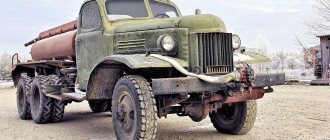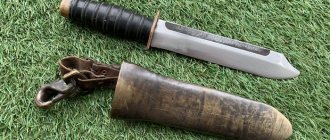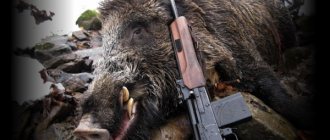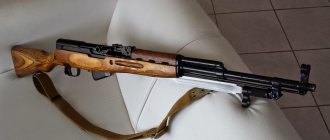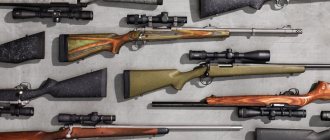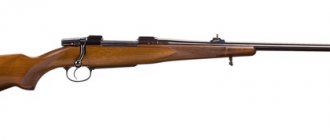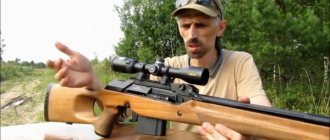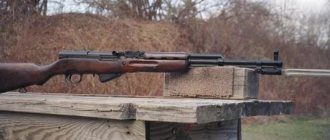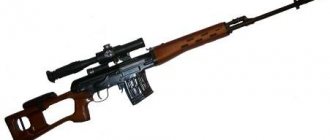The family of shortened rifled hunting rifles, produced under the Los brand name of various modifications, has earned a high reputation due to its high combat qualities, affordable price and adaptability to Russian weather and climatic conditions. Objectively speaking, if we compare this type of weapon with some Western models, the “Moose” can hardly be positioned as the best carbine for hunting.
However, the product line of the Russian manufacturer has a number of features and advantages. And if the choice of a carbine is associated with the desire to save money while ensuring reliability, combat accuracy and a completely acceptable sighting range, then the “Los” is quite capable of ensuring full compliance with these requirements.
History of creation
Created in the late 60s, the “Los” brand hunting carbine was the result of the natural evolution of its famous predecessors - the legendary Mosin rifle model 1891/30 and the lesser known so-called “cavalry carbine” of 1947. The first representative of a civilian (hunting) weapon of this type was a model under the symbol B-9, developed in 1965 for a rather weak cartridge of 9.3x53 mm caliber. Today this weapon is known as the “Los-7.1” carbine (or “Los-9” in earlier modifications, “Los Legion”) and does not enjoy the ardent love of hunters due to the insufficient dynamic characteristics of the cartridge.
However, since the Soviet Union was in dire need of a high-quality, first of all, commercial hunting rifle, not inferior in its performance characteristics to Western models, but noticeably superior to them in cost, modification work was continued. As a result, the choice of domestically produced hunting carbine has been replenished with a whole scattering of modifications, developed for various types of cartridges and having different tactical and technical characteristics.
Ammo
For the most common and popular modifications of the carbine, cartridges with a caliber of 7.62 are used. There are also options designed for more powerful cartridges; they can be either foreign or Russian-made.
There are five cartridges in the magazine. In the classic model, the Los carbine is equipped with an integral box magazine. It is hidden in the weapon itself, and modern variations of carbines have detachable and convenient magazines. The cartridges in them are arranged in a checkerboard pattern.
Peculiarities
One of the main features of the Elk family of hunting weapons is the rifled barrel. After all, this hunting carbine traces its ancestry to the famous “three-line”! And if the first modifications used a semi-shell cartridge of 9.3 caliber (a la Parabellum), which was quite unusual for domestic spaces, then later variants appeared, “tailored” for the standard Soviet cartridge 7.62x51 with a pointed bullet, which has a much higher initial speed and stopping power.
Another feature that this gun has is the ability to use an optical sight, which absolutely does not interfere with the use of a conventional diopter.
The design of almost all variants in which the “Los” hunting rifle is produced today is capable of operating effectively in temperature conditions from -25 to +50°C, and the target firing range is 300 meters, which, coupled with high kinematics of the bullet and 5-round box magazines (tribute to the memory of “Mosinka”) allows you to hunt the largest animal.
In terms of their layout, most models of this family represent a classic hunting carbine with a rigidly fixed barrel 550 mm long, which is locked using two stops and a special bolt handle.
Like the combat version, this hunting rifle fires a shot in four actions:
- Feeding a cartridge with locking the barrel while simultaneously cocking the striking mechanism.
- Actuation of a spring striker, which ensures the firing of the cartridge.
- Removing a spent cartridge case or misfired cartridge from the barrel using an extractor.
- Mechanical feeding of a new cartridge from the magazine.
Aim
The “Los” carbine collects the following reviews about the sight: the gun’s sight is made open, its functions and position make it possible to fire by installing an additional optical sight. The sight device also allows you to hit targets at a distance of up to five hundred meters. On the barrel itself there is a rear sight and front sight, which are a one-piece structure with a rail for the sight. The bar has markings containing digital values from one to five. These data correspond to positions from one hundred meters to five hundred. If necessary, it is possible to set a specific position using a moving clamp.
There is a modification of the carbine with a mechanical sight, for a position of up to three hundred meters.
Advantages and disadvantages
Thanks to its design capabilities and technical characteristics, the “Los” hunting carbine has the following advantages:
- A simple and reliable design that does not require much effort during operation and maintenance.
- High sighting range and stopping power of ammunition.
- Good characteristics of accuracy and combat density, achieved by the design of the barrel with four rifling.
On the other hand, weapons are characterized by certain disadvantages, the main ones being:
- Insufficient quality of processing of the barrel bore, especially in models of early modifications.
- Relatively low quality of fit of plastic parts and tight movement of the bolt handle.
- The rate of fire is relatively low if we compare the “Moose” carbine with a type of weapon such as, for example, a shotgun or a hunting rifle with an autoloader.
However, when deciding which carbine to choose for hunting, fans of reliable, long-range and relatively light weapons should in no case let the “Moose” gun of various modifications slip from their attention! Moreover, today on the domestic hunting market there are variants of this weapon that can satisfy any, even the most sophisticated taste.
Carbine "Moose": reviews and characteristics
According to user reviews, this gun can withstand temperature changes well; it works without any problems in the range from plus fifty to minus fifty degrees. In fact, this is a device designed on the basis of Soviet and Russian military weapons. It was adapted for professional commercial hunting.
The gun's bolt is longitudinally sliding; it rotates when the barrel channel is locked. Characteristics: the “Los” carbine is a rifled weapon, self-loading, the rifling is right-handed, and the bore is chrome-plated.
Overview of modifications
Of course, since the creation of the Mosin rifle and the cavalry shortened model of small arms created on its basis, weapons progress has made a giant leap forward. Today, the “Los” carbine bears little resemblance to its predecessors of the past, and even more so to the century before last. Modern models of this family consist of the following modifications.
Los-7
The “Los-7” hunting carbine, developed for a 7.62x51 mm (A) caliber cartridge, compatible with ammunition of the corresponding caliber of NATO countries, replaced the model with the “4” index, which was discontinued in 1991. In addition, the 7th version has a version developed for the 5.6x39 cartridge, while the Los-4 carbine did not have a modification for a lightweight cartridge.
The peculiarity of the “seven” lies, in particular, in the fact that the rifle magazine is an integral structure. Structurally, the Los 7 carbine largely repeats the features of its predecessor.
Los-7.1
The main difference that the Elk 7.1 hunting carbine has is its removable magazine. As for the design, characteristics, dimensions and weight, this modification is similar to the “pure seven”.
Series 9 family
The newest generation of hunting weapons of this family, which includes three modifications.
The product line that makes up the Los-9 carbine brand consists of the following samples:
- carbine Los 9.1, using a 9.3x64 mm cartridge;
- modification 9.2, developed for the classic NATO “civilian” ammunition 7.62mm Brenneke;
- hunting carbine "Los-9.3", caliber 7.0x65 mm.
Thus, the “Los” brand carbine hunting weapon is a serious competitor to rifles and carbines from Western manufacturers, which are quite expensive, often capricious and not always adapted to Russian climatic conditions. It should be noted that the hunting weapons of this series, among other things, served as a prototype and a kind of “relative” of shotguns and rifles of the “Bars” family, which have similar characteristics, but differ in some design features and the use of more modern materials.
MAKSIMOV.SU
photo:
Evgeny Spiridonov The evolution of the Russian hunting rifle
Necessity
in a specialized hunting carbine, simple, reliable and inexpensive, Russia has always had it. In this case, the main factor was precisely the availability and reliability of such weapons, because in our country, unlike the West, hunting usually carried a conceptually different essence - a specific result was needed, not a process.
They hunted in the vast Russian expanses not for entertainment, but for prey. Expensive decorated guns, a feather in the cap and a far-fetched idea of “correct” hunting that was absolutely unsuitable for us - all this did not fit the harsh Russian realities. At the same time, of course, the combat rifle so familiar to us was not always suitable for solving all the problems of a beast hunter.
The 4.2-line bullet of the Berdan rifle had a good stopping effect on the animal, but the Berdan was single-shot, long and heavy. The Mosin's rapid-fire 3-line magazine was inferior to the Berdan rifle in terms of lethality, while remaining just as heavy and long.
Carbine "Los-7-1"
Both
They have repeatedly tried to modify the legendary Russian rifles to meet “classical” hunting requirements, shortening them, making them lighter, improving ergonomics and using cartridges of various equipment. Alas, the desired result, as one would expect, was not achieved - from a military weapon, without serious design changes, it is difficult to obtain a cheap, lightweight, “turnaround”, ergonomic and balanced hunting rifle for mass production.
The famous weapons expert V.E. Markevich developed a 7.62 mm hunting carbine based on the Mosin rifle at the beginning of the 20th century. Judging by the description of Markevich himself, the carbine really turned out quite well, but no one saw it “live”, except as in the drawings. And it is unlikely, judging by the description of changes in the basic model, that the BEM carbine could be so cheap that it could compete with a conventional army rifle.
In 1967, M.N. Blum presented an experimental B-9 carbine, developed on the basis of the Mosin rifle, similar to the one he had created in the 50s. powerful cartridge 9.3x64. Despite the obvious success of the cartridge-rifle complex, this carbine did not go into production. But the cartridge still found application in modern 9-mm Tigers and Elks.
In the 30s of the last century, gunsmith D.M. Kochetov (in 1942, who created a vertical-basic bracket for the launcher for the sniper “three-line”), designed an 8.2-mm carbine based on the Mosin rifle (NK-8.2), which has an original “short-shooting” » wafer cartridge with a lead bullet, filled with black powder.
These carbines are still found today, but due to their weak cartridge (the muzzle velocity is only 400 m/sec), they do not meet the requirements of hunters, ensuring the defeat of only small animals at distances less than 100 m.
After the war and until 1965, Izhmash produced modernized versions of the NK-8.2 carbine under the names KO-8.2 and KO-8.2M, having a cartridge with an initial speed of a semi-jacketed bullet increased to approximately 700 m/s. But this complex also turned out to be imperfect. It should be noted that these particular carbines were already called “Moose”.
For 2 years, starting in 1962, Izhmash produced the A. Shestrikov carbine, which is an upgrade of the KO-8.2M, chambered for 9.3x66 mm. Since 1965, it was this carbine that began to be produced under the new, more powerful Blum cartridge 9.3x53. The new carbine received the index KO-9-1 and the name “Los-9” or simply “Los”, produced until 1977.
This carbine already fully met the aspirations of hunters, except that the direct shot distance, due to the steep trajectory of the bullet, was relatively small - literally up to 150-200 m. Of course, you can also shoot at 250-300 meters using visual corrections; for example, at a moose at such a distance it is enough to aim at the upper back if the carbine is zeroed at 150 meters.
This problem was solved in 1975, when the Central Research Institute of TOCHMASH developed a new 7.62x51A ammunition (non-interchangeable with the Western .308 Win). The new cartridge turned the “Moose” upgraded for it into a full-fledged rifle with a confident shooting range of 300 meters. This is how Los-4 appeared, produced until 1990 and replaced by a new modification, Los-7 (KO-7), featuring a more technologically advanced, simplified design.
The new Los-7 carbine used the 7.62x51M cartridge, a complete analogue of the foreign .308 Win cartridge, which is standard NATO rifle ammunition. Having ballistics similar to those of the Russian three-line cartridge, this cartridge, thanks to the widest range of bullets, is an excellent hunting ammunition, only slightly inferior to ours in terms of energy.
The initial speed of the bullet, depending on the type of cartridge, is up to 830 m/sec. For large bears and moose, this cartridge is rather weak, but it is used everywhere very successfully.
Los-7-1
Since 1995, the Los-7-1 modification has appeared, which has a more convenient and reliable fuse, a removable magazine and a modified front sight.
The carbine sight has settings for 100 and 300 m, and the mechanical sight remains available for use when installing an optical sight. Los-7-1 carbines for various imported ammunition also appeared.
The design of the carbine is technologically advanced, simple and has good performance characteristics. Having a conventional rifle layout, the Los-7 is distinguished by the original design of the trigger and bolt - some parts of the trigger and safety catch, usually located on the receiver, are located on the bolt in the Los.
The Los-7-1 carbines, as well as the Bars-4-1 carbines unified with them, are classic hunting rifles. The 550 mm barrel with 4 rifling is rigidly attached to the receiver, locked with 2 lugs. The bore and chamber are chrome plated. The cartridge case reflector is mounted in the bolt cup. An extractor is located in front of the bolt.
At the rear of the bolt there is a figured groove with a spiral bevel, which serves for cocking the firing pin. It is poor quality processing or a violation of the geometry of this bevel that causes the “tight” cocking of the bolt handle. That is why Legion carbines initially, and serial carbines after 500 shots, work much easier.
In the boss of the bolt handle there is a socket for the trigger housing lock and a recess for the safety. Inside the bolt stem there is a channel in which the firing pin and firing pin are located, the mainspring is located in the internal channel of the firing pin.
At the rear of the firing pin there is a protrusion with a bevel that interacts with a figured bevel on the rear of the bolt stem. The end of the rear part of the sear is the combat cocking of the striker.
The trigger housing assembly is fixed to the bolt with a spike located in its middle part and is a complex part that has milled grooves for the sear and the trigger lever.
At the end of the rear thickened part of the SM body there is a hole for a spring-loaded bend that fixes the position of the body on the bolt. It is possible to adjust the force and nature of the descent. The trigger travel adjustment range is 2-4 mm, the trigger force is 0.76-1.53 kgf. The safety locks the sear.
The body of a removable double-row magazine that holds 5 rounds is attached to the bottom of the receiver. It must be admitted that the magazine has an extremely poor design - its lower part, made of plastic, dangles and rattles even in “tuned” models.
The magazine locking mechanism is unreliable - on some rifles, if you do not control the magazine after each shot (by hitting it with your hand from below), then during shooting you can lose it, or, worse, it will move a couple of mm down (visually almost imperceptibly) and the weapon will have to be reloaded will not be.
The rifle stock has a pistol grip and is made of birch or walnut. The metal parts of the carbine are coated with phosphate varnish. The total length of the rifle is 1060 mm, weight is about 3.5 kg.
Conclusion
Those hunters who do not like the militarized “Tigers”, “Bears”, “Veprs” and “three-line rifles”, choose a classic hunting rifle with a longitudinally sliding rotary bolt. Among inexpensive, reliable, accurate and convenient weapons, our Los carbine is a completely justified choice.
The author of the article had the first opportunity to shoot from the Los-7-1 carbine several years ago, in the Moscow region. It was an ordinary carbine, in an unsightly birch stock, with no distinctive treatment of the external surfaces of the metal parts. At the same time, it had a simply wonderful trigger, the bore was without “interceptions” or “barrels”, and the sight on it was quite good - a 7x Lupold.
Shooting from this “Moose” was more of an informational nature. All the greater was my surprise when, for the first time shooting from this carbine, in 20-degree frost, without much aiming, with the cheapest and not the highest quality Barnaul cartridges, the very first series of 5 shots managed to be fired at 30 mm at 100 meters (1 corner minute). No problems were noted during shooting. The owner of the rifle explained that with a good cartridge he gets about 0.5 MOA from it...
Of course, not every “Moose” has such, dare I say it, outstanding combat characteristics. Moreover, all these rifles differ both in accuracy and in build quality. Of course, the main thing is the barrel, which in Russia is traditionally made with high quality.
But when purchasing, you should carefully select a rifle, preferably using measuring calibers. Moreover, this is mandatory not only when purchasing domestic rifled weapons - outright defects among foreign-made rifles are by no means uncommon.
In any case, the accuracy of any individual Los rifle usually does not exceed 60-80 mm with the cheapest cartridge, which is more than enough for most Russian hunts.
And with a selected barrel, correctly placed hardware in the stock, a high-quality optical sight, a well-adjusted trigger and a selected cartridge, you can get a very accurate hunting rifle, quite competitive at the shooting range and in hunting with all the current variety of foreign systems. At the same time, the price of “Moose” is sometimes several times lower than its imported analogues.
If you want to have an exclusive rifle, you can order it from a company specializing in individual finishing of weapons. As a result, you will have an impeccable rifle at a very reasonable cost. It is just such a sample, made by order of Evgeny Spiridonov, that you see in the photographs illustrating this article.
A beautiful and elegant rifle, with an excellent action. With a passport figure of 33 mm at the 100th distance, Evgeniy has already achieved a group of 17 mm, which, given the progressive improvement in the rifle’s accuracy, is not the end result.
If everything is clear with the choice of a rifle, then owners sometimes have questions about the fine-tuning. The biggest problem is the tight movement of the shutter handle, especially when opening it. As mentioned above, the reason for this is poor-quality processing of the kinematic pair “bevel of the bolt stem - firing pin protrusion”, as well as poor processing or incorrect geometry of the pair “base of the bolt handle - copier of the rear part of the receiver”.
When the bolt handle moves upward, when reloading the carbine, it is these listed shaped contact surfaces that create a large force. When the chamber is inflated, additional force on the bolt handle will be transmitted by preliminary release of the cartridge case.
To the heap, defects in the processing of the receiver channel contribute to the deterioration of the smoothness and ease of movement of the bolt. Of course, poor processing is bad, but expecting miracles from cheap weapons is too much.
If you are not satisfied with the tight movement of the bolt, then it is necessary to grind and polish all the contact surfaces of the bolt and the receiver, preferably checking the mating “for soot”. To identify problem areas that have “extra” metal” or a rough surface, it is necessary to “understand” the operation of the mechanics of the rifle, try to “listen” to the metal while slowly jerking the bolt.
If you concentrate, then you will not only visually, not only auditorily, but also tactilely feel the localization of all defects in the processing of the internal surfaces of the receiver and understand the reason for all the jamming and disruption of the smooth operation of the shutter. Try it, understand it, sand it, lubricate it, it’s not difficult, just don’t be fanatical.
And by bringing the mechanics of your favorite rifle to perfection, you will receive not only pleasure from the excellent operation of the bolt, but also satisfaction from the work done. Of course, without any locksmith skills, it is better not to risk it and give the rifle to a master.
But where can you sometimes find him, a master, somewhere in a remote province? So you have to learn everything on your own. And the Russian hunter has always been famous for his “handedness” and ingenuity; we don’t live in pampered gardening Europe.
PS:
I am sure that the author of the letter to the editor of the magazine “Hunting”, asking about the possibility of modifying the bolt of his rifle, will be able to independently improve the operation of its mechanics. The holes on the body of the Los-7-1 trigger mechanism are a structural element. A spring-loaded ball fits into these wells as the bolt rotates during reloading and disassembly, ensuring positive locking in extreme positions.
The bolt of his rifle is not defective, the clicks of the latch are not a defect. And all rifles “click” when reloading. If the clicks are too loud and “hard”, you can try to carefully polish the “holes” on the trigger body and the latch itself; when assembling the shutter, you can lubricate the parts with a thin layer of graphite lubricant.
The article was published in the magazine "Hunting"

